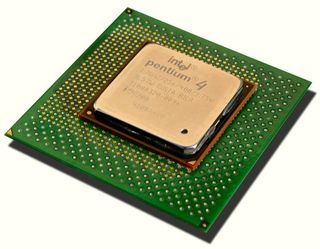Intel Pentium 4 1.7 GHz: More Power For Less Money
Pentium 4 1.7 GHz

As a technical reviewer, I am sadly lacking the ability to foretell the future, so I will stick to what I am able to do, which is checking and testing the technical features of Pentium 4 1.7 GHz. After that, I can tell you if I consider it worth its price.
The new Pentium 4 1.7 GHz processor isn't much different to its older siblings at 1.3, 1.4 and 1.5 GHz. The looks, weight, taste and smell are identical and the silicon chip underneath the cover is also not different to previous Pentium 4 dies. The only real difference between P4 1.7 and its predecessors is its voltage of 1.75 V (P4 1.5 GHz requires 1.7 V only) and therefore its power consumption and heat production. Intel is using the good old overclocker's trick to improve the clock speed margin and raised the core voltage a little. All other facts remain, including the fixed multiplier of Pentium 4, which makes 'responsible overclocking' rather difficult indeed.
If you want to learn more about the innards and previous performance evaluations of the Pentium 4 processor, I advise you to read our previous Pentium 4 articles, which are:
- Intel's New Pentium 4 Processor
- Important Pentium 4 Evaluation Update
- Painting a New Picture of Pentium 4: Tweaked MPEG4 Encoding
- Tom's Blurb: Pentium 4 - Another Recount?
- Final Recount: Pentium 4 vs. Athlon
Basically, Pentium 4 is a new design, which has some problems with today's software. Particularly office applications like Word or Excel, but also current 3D-games perform quite a bit worse on Pentium 4 than on Athlon, although the AMD-processor runs at lower clock speeds. Once software has been compiled for Pentium 4 however, the trace cache architecture is able to show its advantages. The same is valid for Pentium 4's floating-point performance. While Pentium 4's normal FPU lags significantly behind Athlon's FPU, the Intel processor comes with the new SSE2-extensions, which offer very high FPU-performance for applications that are able to benefit from streaming floating point operations and that are actually programmed or at least compiled for the usage of the SSE2-extensions. In summary you could say that Pentium 4's architecture doesn't make it exactly a top-notch performer right now, but it could perform a lot better in the future, once applications have been optimized for this processor. High clock speeds are the best way to cover up Pentium 4's performance problems with current software, which is why Intel was eager to release Pentium 4 1.7 GHz as soon as possible.
Stay On the Cutting Edge: Get the Tom's Hardware Newsletter
Get Tom's Hardware's best news and in-depth reviews, straight to your inbox.
Most Popular


